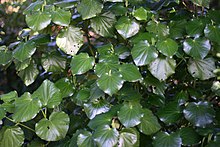Tangihanga

Tangihanga,or more commonly,tangi,is a traditionalfuneral ritepractised by theMāori peopleof New Zealand.Tangiwere traditionally held onmarae,and are still strongly associated with the tribal grounds, but are now also held at homes andfuneral parlours.[1]While still widely practised,tangiare not universally observed, and some tribes have expressed concerns about lower numbers oftangi.[2]
Modern practises
[edit]Tribes—at the level ofiwiorhapū—differ in how they honour those who die.Tangihangagenerally take three days, with burial on the third day. From the moment of death, the body of the deceased (tūpāpaku) is rarely alone.[1]Thetūpāpakuis transported (usually from a hospital and via a funeral home) to themarae.There they are welcomed with apōwhiriand willlie in statefor at least two nights, usually in an open coffin, in thewharenui.

Throughout thetangihanga,thetūpāpakuis flanked by the bereaved family (whānau pani;[3]sometimes called thekirimateor mourners),[4]who take few and short breaks, dress in black, and sometimes wreath their heads inkawakawaleaves. Around the coffin, flowers and photographs of deceased relatives are placed.
Visitors come during the day, sometimes from great distances despite only a distant relationship, to address the deceased. They may speak frankly of his or her faults as well as virtues, but singing and joking are also appropriate. Free expression of grief by both men and women is encouraged. Traditional beliefs may be invoked, and the deceased is told to return to the ancestral homeland,Hawaiki,by way ofte rerenga wairua,the spirits' journey. The close kin may not speak. It is traditional for mourners to wash their hands in water and sprinkle some on their heads before leaving the area where thetūpāpakulies in state. Traditionally, the visitors would bring famoustaonga(treasures), such askākāandkiwifeather cloaks andpounamumere,which would be placed alongside thetūpāpaku.These items were inherited by the heirs of the deceased, who were then expected to return them to the original owners at subsequenttangihanga.This practice was calledkōpaki.[5]
On the last night, thepō whakamutunga('night of ending'), the mourners hold a vigil and at a time assigned by custom (sometimes midnight, sometimes sunrise) the coffin is closed, before a church ormaraefuneral service or graveside interment ceremony, invariablyChristianin modern times. As with the area thetūpāpakulies, it is traditional for mourners to wash their hands in water and sprinkle some on their heads before leaving the cemetery. After the burial rites are completed, a feast (hākari) is traditionally served. Mourners are expected to providekoha('gifts', typically money) towards the meal. After the burial, the home of the deceased and the place where the deceased died are ritually cleansed withkarakia(prayers or incantations) and desanctified with food and drink, in a ceremony calledtakahi whare,'tramping the house'.[6]That night, thepō whakangahau('night of entertainment') is a night of relaxation and rest. The widow or widower is not left alone for several nights following.
Both in traditional times and modern, thetangiof high-profile individuals can be both extended and elaborate.[7][8]
A2011 court caseover a disputed resting place ruled that Māoricustomary lawcould not be applied to funeral traditions undercommon law,as the customary law allows force to settle legal disputes.[9]
References
[edit]- ^ab"Tangihanga – Korero Maori".Korero.maori.nz. Archived fromthe originalon 26 January 2022.Retrieved3 December2013.
- ^"Demise of tangi a threat to culture – professor – Maori – NZ Herald News".Nzherald.co.nz. 9 June 2012.Retrieved3 December2013.
- ^"pani".Archived fromthe originalon 25 April 2012.Retrieved22 November2011.
- ^"kirimate".Archived fromthe originalon 25 April 2012.Retrieved22 November2011.
- ^Grace, John Te Herekiekie (1959).Tuwharetoa: The history of the Maori people of the Taupo District.Auckland [N.Z.]: A.H. & A.W. Reed. p. 292.ISBN9780589003739.
- ^"takahi whare".Te Aka Māori Dictionary.Retrieved2 May2023.
- ^"Papers Past—Auckland Star, 22 September 1894. p. 2".Paperspast.natlib.govt.nz. 2011.Retrieved19 June2011.
- ^"Sir Howard laid to rest Tuesday".Stuff.co.nz. 2011.Retrieved19 June2011.
- ^Mike Watson (23 November 2011)."Bodysnatching decision: Law before Maori custom".Stuff.co.nz.Retrieved3 December2013.
